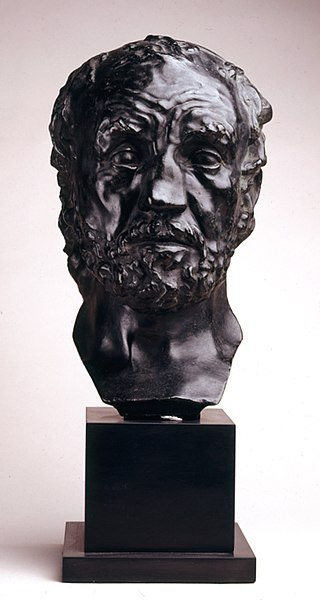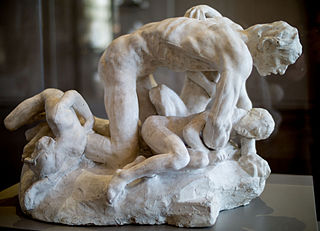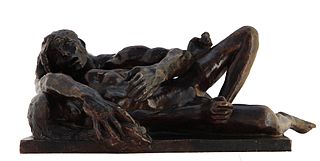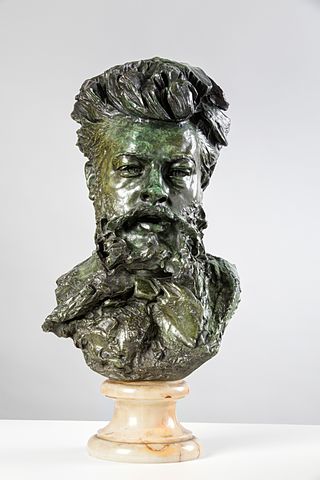
The Martyr or The Little Martyr is a c.1885 plaster sculpture of a naked dead or sleeping female figure by Auguste Rodin, now in the Musee Rodin.

The Alsatian Orphan / L'Orpheline Alsacienne is a sculpture made by the French artist Auguste Rodin (1840-1917). In the beginning of his career, Rodin made decorative pieces. This piece was created during this phase.

Man with the Broken Nose is a sculpture by Auguste Rodin created between 1863 and 1864 and approved by the Salon in 1875. It is considered the first by Rodin in which life is represented over the grace pervading the academic circles and aesthetic of the time.

The Falling Man is a sculpture by French artist Auguste Rodin modeled in 1882 and is part of Rodin's emblematic group The Gates of Hell.

I Am Beautiful, also known as The Abduction, is a sculpture of 1882 by the French artist Auguste Rodin, inspired in a fragment from Charles Baudelaire's collection of poems Les Fleurs du mal.

Fugitive Love is a sculpture by Auguste Rodin made between 1886 and 1887, both sculpted in marble and cast in bronze. It represents a man and a woman embracing each other on top of a rock. More specifically, the author was inspired by the story of Francesca da Rimini's love affair with Paolo Malatesta, an allusion to Dante Alighieri's depiction of lust on the second circle of Hell in his Inferno.

Ugolino and his sons is a plaster sculpture by French artist Auguste Rodin, part of the sculptural group known as The Gates of Hell. As an independent piece, it was exhibited by its author in Brussels (1887), Edinburgh (1893), Genoa (1896), Florence (1897), Netherlands (1899) and in his own retrospective in 1900.

Avarice and Lust is a sculpture by French artist Auguste Rodin, conceived between 1885 and 1887, representing two of the seven capital sins and is part of his sculptural group The Gates of Hell, where it can be found in the lower part of the right door. It's possible that the name was inspired by Victor Hugo's poem Après une lecture du Dante:

Head of Camille Claudel is a polychrome glass paste sculpture by the French artist Auguste Rodin, conceived in 1884 and executed in 1911. It is now in the Museo Soumaya in Mexico City. It shows his then studio assistant Camille Claudel in a Phrygian cap.

The Bust of Maurice Haquette is an 1883 bronze sculpture by the French artist Auguste Rodin, measuring 53.5 by 26.7 by 41.1 cm.

Danaid is a sculpture by Auguste Rodin, based on the account in the Metamorphoses of Hypermnestra, eldest of the Danaïdes.

Andromeda is a sculpture by the French artist Auguste Rodin, named after Andromeda. It is one of the sculptures produced as part of his The Gates of Hell project and appears on the left door next to the personification of Day and on the right door as part of the group showing a falling winged genius.

The Old Tree is a plaster sculpture by the French artist Auguste Rodin, originally conceived as part of his The Gates of Hell project.

The Kneeling Man is a work originally conceived in 1888 by the French artist Auguste Rodin for his The Gates of Hell project.

Youth Triumphant is one of the sculptures created by Auguste Rodin as part of the planning for his The Gates of Hell. It was inspired by Jean Dampt's The Grandmother's Kiss, exhibited in 1893. That work shows a young woman resting in the arms of an old woman, with the pair deeply kissing.

Young Mother is a bronze sculpture by Auguste Rodin with a brown and green patina, conceived in 1885 and cast by the Rudier Foundry.

Ovid's Metamorphoses or The Satyrs is a sculpture by Auguste Rodin, created as part of The Gates of Hell.

Meditation or The Interior Voice is an 1886 sculpture by Auguste Rodin, showing a young woman resting her head on her right shoulder.

Paolo and Francesca is a sculptural group by Auguste Rodin, showing Paolo and Francesca da Rimini, damned lovers from Canto V of Dante's The Divine Comedy.

Torso of Adele is an 1878-1884 sculpture by the French artist Auguste Rodin, originally modelled in plaster before being worked in terracotta.




















